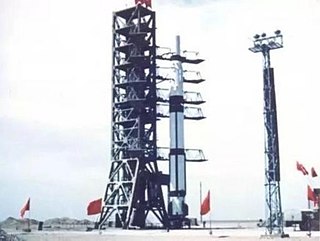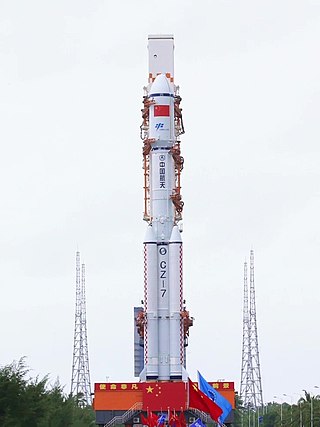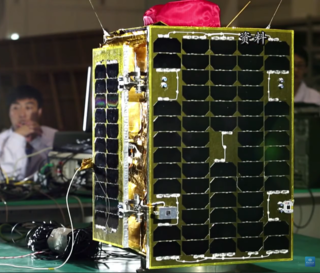Related Research Articles

An expendable launch system is a launch vehicle that can be launched only once, after which its components are either destroyed during reentry or discarded in space. ELVs typically consist of several rocket stages that are discarded sequentially as their fuel is exhausted and the vehicle gains altitude and speed. As of 2022, most satellites and human spacecraft are currently launched on ELVs. ELVs are simpler in design than reusable launch systems and therefore may have a lower production cost. Furthermore, an ELV can use its entire fuel supply to accelerate its payload, offering greater payloads. ELVs are proven technology in widespread use for many decades.

The space program of the People's Republic of China is directed by the China National Space Administration (CNSA). China's space program has overseen the development and launch of ballistic missiles, thousands of artificial satellites, crewed spaceflight, an indigenous space station, and has stated plans to explore the Moon, Mars, and the broader Solar System.
The YF-77 is China's first cryogenic rocket engine developed for booster applications. It burns liquid hydrogen fuel and liquid oxygen oxidizer using a gas generator cycle. A pair of these engines powers the LM-5 core stage. Each engine can independently gimbal in two planes. Although the YF-77 is ignited prior to liftoff, the LM-5's four strap-on boosters provide most of the initial thrust in an arrangement similar to the European Vulcain on the Ariane 5 or the Japanese LE-7 on the H-II.

The YF-100 is a Chinese liquid rocket engine burning LOX and kerosene in an oxidizer-rich staged combustion cycle.
Project 921-3 is a crewed spacecraft sub-system of Project 921. The term 921-3 is often used for the Chinese spaceplane program.

The Long March 7, or Chang Zheng 7 in pinyin, abbreviated LM-7 for export or CZ-7 within China, originally Long March 2F/H or Chang Zheng 2F/H, nicknamed Bingjian, is a Chinese liquid-fuelled launch vehicle of the Long March family, developed by the China Aerospace Science and Technology Corporation (CAST). It made its inaugural flight on 25 June 2016.
The YF-115 is a Chinese liquid rocket engine burning LOX and kerosene in an oxidizer-rich staged combustion cycle. A high efficiency/high thrust environmental-friendly rocket engine was always an objective within Programme 863. Development began in the 2000s, along with its sibling, the bigger YF-100, which would power the LM-5, LM-6 and LM-7 boosters and first stages. Testing was directed by the China National Space Administration (CNSA) commencing in 2005. Development works are mainly carried out by the Xi'an Aerospace Propulsion Institute. It will be used as upper stage engine for China's next generation of medium and light environmental-friendly launch vehicles, namely the Long March 6 and the Long March 7. During early 2012, the engine system successfully passed vacuum testing. It is China's first upper stage rocket engine to adopt the staged-combustion cycle.
i-Space —also known as Space Honor, Beijing Interstellar Glory Space Technology Ltd., Interstellar Glory or StarCraft Glory—is a Chinese private space technology development and space launch company based in Beijing, founded in October 2016.

The TQ-12 is a gas-generator cycle rocket engine burning liquid methane and liquid oxygen under development by Landspace. TQ-12 is the first Chinese liquid rocket engine developed with private funding. The engine has been designed to produce 670 kilonewtons (150,000 lbf) of thrust at sea level.

Jilin-1 is China's first self-developed commercial remote sensing satellite system. The satellites are operated by Chang Guang Satellite Technology Corporation and named after Jilin Province where the company is headquartered. The first set of satellites were launched by Long March 2D in Jiuquan Satellite Launch Center on 7 October 2015, at 04:13 UTC. All launched Jilin-1 satellites are in sun-synchronous orbit (SSO).
Tiantong is China's first mobile communications satellite system. The first satellite Tiantong-1-01 was launched on August 6, 2016 (UTC+8).
The YF-130 is a Chinese rocket engine fueled by LOX and kerosene in an oxidizer-rich staged combustion cycle currently in development. It has been designed to reach around 500 tonnes of thrust and it will power the super heavy Long March 9 rocket.
Space Pioneer, also known as Beijing Tianbing Technology Co., Ltd., is a Chinese aerospace company developing reusable orbital rocket technology—both launch vehicles and liquid rocket engines—to access the market for low-cost space launch services. The company is aiming to meet launch requirements for both the Chinese national satellite internet project and also the CNSA solicitation for resupply of the Tiangong space station.
Chen Qizhi was a lieutenant general (zhongjiang) of the People's Liberation Army (PLA) who served as president of National University of Defense Technology from 1990 to 1994. He was a delegate to the 4th and 5th National People's Congress.
The YF-79 is a liquid cryogenic rocket engine burning liquid hydrogen and liquid oxygen in a closed expander cycle. It is China's fourth generation of upper stage cryogenic propellant engine, after the YF-73, YF-75 and the YF-75D. It can do multiple restarts thanks to an electric spark igniter and a prototype was tested at 60% and 100% thrust levels in December 2021.
The Long March 6A or Chang Zheng 6A as in pinyin, abbreviated LM 6A for export or CZ 6A within China, is a Chinese launch vehicle of the Long March family, which was developed by the China Aerospace Science and Technology Corporation (CASC) and the Shanghai Academy of Spaceflight Technology (SAST). The vehicle is a further development of the Long March 6, with 2 YF-100 engines on the first stage as opposed to 1 on the Long March 6, augmented by 4 solid rocket boosters. The Long March 6A is China's first rocket with solid rocket boosters. The maiden launch of the Long March 6A took place 29 March 2022, successfully reaching orbit. It was also the first launch from the newly built launch complex 9A in Taiyuan.
The YF-102 is a Chinese liquid rocket engine burning LOX and kerosene in a gas generator cycle. It is manufactured by the AALPT based on the experience of previous kerolox engines, and using 3D printing technology and is capable of multiple restarts. It is used in Tianlong-2 launch vehicle developed by Space Pioneer.
The TH-12 is an oxidizer-rich gas-generator cycle rocket engine burning LOX and kerosene under development by Space Pioneer. The TH-12 utilizes 3D printing and has the highest target thrust among all commercial rocket engines in China. The engine features deep throttling for reusability, re-ignition, thrust vectoring, and multi-mode starters.
The YF-90 is a liquid cryogenic rocket engine burning liquid hydrogen and liquid oxygen in a staged combustion cycle. It is China's first hydrogen-oxygen engine to use the staged combustion cycle and is expected to be used for the second stage of the Long March 9, which is a three-stage rocket with boosters. The engine has advanced features such as variable thrust, multiple ignitions, and automatic fault diagnosis.
References
- ↑ "天火-11 - 天火系列发动机 - 天兵科技". www.spacepioneer.cc. Space Pioneer. Retrieved 13 April 2023.
- 1 2 "天兵科技液体火箭发动机全系统热试车圆满成功,突破我国航天多项首创技术". finance.sina.cn. Sina. 1 June 2021. Retrieved 13 April 2023.
- ↑ Beil, Adrian (7 April 2023). "Chinese Tianlong-2 successfully debuts from Jiuquan". NASASpaceFlight.com. Retrieved 13 April 2023.
